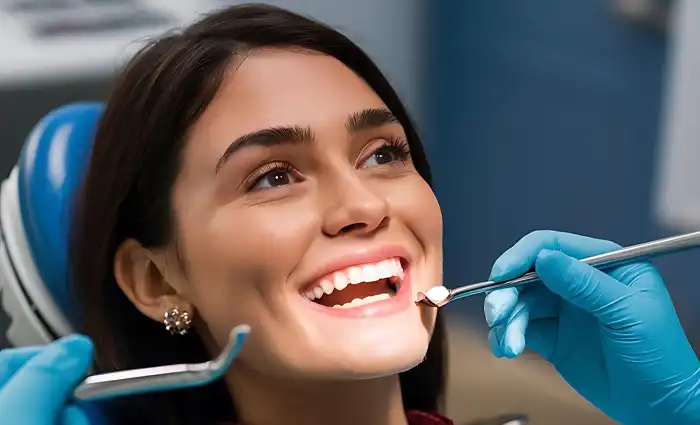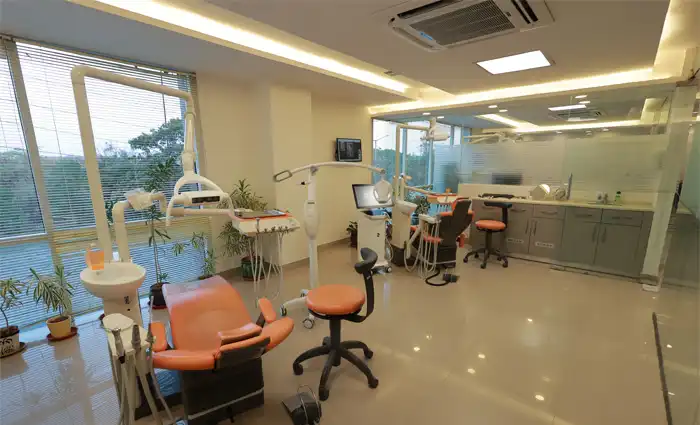Smile Design
Your smile is one of the first things people notice about you, and having a confident, beautiful smile can enhance your overall well-being. Smiling triggers the release of serotonin and endorphins, which help reduce pain and lower blood pressure. However, issues such as tooth discoloration, misaligned teeth, or cracked teeth can prevent people from expressing themselves freely. Digital Smile Design (DSD) can help address these concerns by offering a precise, predictable, and highly personalized approach to smile enhancement.

What is Smile Design?
A smile design procedure is made up of a series of different dental treatments that serve to improve the overall health and look of your teeth. It could be transformative, as it could give you a brighter, more confident, and more natural smile. The journey to a perfect smile starts with a consultation where the dentist listens to your dental concerns and gives recommendations regarding the procedures, but first the dentist makes sure to address any underlying dental issues before beginning the cosmetic treatment.
When you are in doubt about the treatment you have to undergo because you are unable to get a clear picture of the end results, your dental clinician may use Digital Smile Designing (DSD) as a support tool. DSD provides an aesthetic visualization of your dental concerns, thus offering logical solutions. This way, you learn and realize the necessity of certain procedures. Digital smile design allows for creating and presenting a new smile using surgical simulation through visualization of the end result of the treatment. You are involved in the smile design process, ensuring that your needs and desires are incorporated into the final product—your new smile. This personalized approach improves your confidence, boosts emotional connection, and secures your approval of proposed treatment options.
DSD uses digital tools that are normally available in modern-day dental clinics, including a computer with DSD software, a digital Single-Lens Reflex (SLR) camera, or even a smartphone. Additional instruments, such as a digital in-office scanner for impressions, a 3D printer, and Computer-Aided Design (CAD)/ Computer-Aided Manufacturing (CAM), may also be used for a complete digital 3D workflow. Appropriate photographic documentation is very important for facial and dental analysis, which gives an idea of changes and design. Video documenting is also important for the dynamic analysis of teeth, gums, lips, expressions, or various positions or sequences to include facially guided principles in smile design later on.
Smile Digital Design (DSD)
When uncertain about the outcome of your treatment, Digital Smile Design (DSD) serves as a powerful support tool. DSD provides an aesthetic visualization of your dental concerns, offering logical solutions and enabling a clearer understanding of necessary procedures.
With Smile Digital Design, you can preview the potential results of your treatment through a digital simulation. This personalized approach ensures your needs and desires are incorporated into the final outcome—your new smile. DSD not only boosts confidence but also enhances patient-dentist communication, ensuring your approval before beginning treatment.
DSD utilizes advanced digital tools commonly available in modern dental clinics, including:
DSD software on a computer
Digital Single-Lens Reflex (SLR) cameras or smartphones
Digital in-office scanners for impressions
3D printers and CAD/CAM technology for a fully digital workflow
High-quality photographic documentation plays a vital role in facial and dental analysis, offering insights into potential changes. Additionally, video documentation allows for dynamic analysis of teeth, gums, lips, and facial expressions, ensuring an optimal smile design based on facially guided principles.
Common Goals of Smile Design
An aesthetic smile design aims to establish a peaceful and balanced oral system. For a desired outcome that is healthy as well as aesthetic, it is important to acknowledge the interrelationship of all oral structures, such as muscles, bones, joints, and gum tissues. The entire smile design treatment period varies from three weeks up to six months according to the exact procedures; sometimes an overall smile design procedure may even require up to one year.
Smile Design Process and Designing a Customized Treatment Plan
The dentist will present various options, including tooth recontouring to achieve an even smile line and improve the symmetry of the teeth. There are occasions where the tissue architecture has changed and exposed dark metal margins; old crowns might need to be replaced with new full porcelain ones without any metal.
Dentists often take an impression of your teeth to make study models, which are later adjusted in wax. In the end, models are finished and shared with you to review changes made and ensure smile goals are accomplished.
If you decide to change your teeth shape or color, the dentist might suggest porcelain veneers as a solution to achieve the desired outcome. Later, the dentist will look at the gum line to see if any changes are required so that a beautiful and symmetrical appearance can be achieved.
Should there be decay in any of your teeth or they need to be extracted, the dentist may propose having an implant. Choosing a dental implant process can improve overall dental health in the long term. Implants have a longer lifetime as compared to other treatment options.




